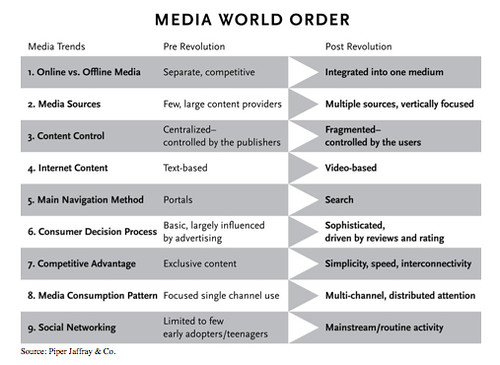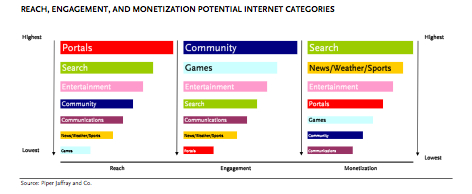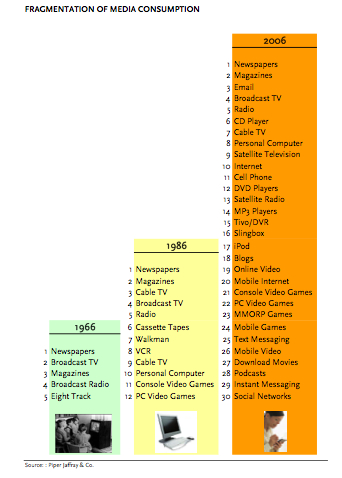Semantic web
Tim Berners-Lee Says the Time for the Semantic Web is Now – The semantic web is designed to be machine readable. The underlying technologies supporting the semantic web are used to formally represent metadata. For example, ontology can describe concepts, relationships between entities, and categories of things. The most interesting thing about Berners-Lee’s interview is that he thinks that the semantic web will be closer to Google’s vision through database manipulation rather than folksonomy. I think you will need a combination of both for a semantic web that works
China
Masters of Media, New Media MA Amsterdam » Chinese low-wage workers disloyal for a reason – Chinese workers sticking it to the man and wanting an independent China to kick multi-national mega corp. bootie
Consumer behaviour
Technology Can Be a Blessing for Bored Workers – New York Times
Americans Trust Online News More Than TV | WebProNews – online trusted more than TV. Does this say more about the rise of online or the pitiful state of TV news journalism? I don’t know
White working class ‘voiceless’ – A majority of white working class Britons feel nobody speaks for people like them, a BBC survey has suggested. Some 58% said they felt unrepresented compared to 46% of white middle class respondents to a Newsnight poll.
Design
Normal Room – home for global homes, wonderful lifestyles and fabulous interior design – Home – for interior design junkies
Olympus Announces ‘World’s Smallest and Lightest’ DSLR – Consumer-SLR – but you dont want a camera thats too light because then you get issues wtih camera shake
Ethics
YouTube – Edison Chen Sex Scandal Apology – Hopefully this will finish once and for all the scandal and allow all the starlets to keep their jobs in the Asian entertainment industry. It would be a shame if Maggie Q had to retire :)
I, Cringely . The Pulpit . Leadfoot | PBS – interesting post on the false green measure of lead-free solder
FMCG
Kit Kat Lucky Little – interesting japanese offline / online integrated marketing idea
BBC NEWS | UK | Tate & Lyle sugar to be Fairtrade – In terms of size and scale, this is the biggest ever Fairtrade switch by a UK company, will the company get held to a holier than thou status and get beaten up on big food issues the way the post-Prius Toyota got beaten up by environmentalists about the conventionally powered cars that it still sells?
How to
7 Food Hacks to Stay Alert Without Caffeine | Zen Habits
Ideas
apophenia: Where HCI comes from (and where it might go)
BIL Conference – Minds Set Free. – TED meets barcamp
The New Economics of Brands – Harvard Business Online’s Umair Haque – Umair has an interesting article on how Google built their brand
Innovation
The World’s Most Innovative Companies | Fast Company – I am surprised that Facebook has scored so highly in this article and we don’t have any of the results of IDEOs commissions described
Japan
SMS Text News » Archives » Japan gets new MVNO and starts price war
Michelin Gives Stars, but Tokyo Turns Up Nose – New York Times – if I go restaurant hunting in Japan, I want to be told by by the Japanese not some French interlopers the best places to go. Also Japan is more wired than most other nations on earth, why the dead tree edition instead of using viaMichelin’s much vaunted mapping on a mobile service?
Tokyo Taxi Drivers get Ranked | Japan: Stippy – not all taxi drivers who pass The Knowledge are equal now Tokyo is recognising their most highly qualified drivers wtih a star system. Cool idea
PingMag – Goodbye Madame Butterfly: Sex And Marriage In Japan – interesting author interview about changing society roles in Japan
Luxury
Digital World Tokyo | World’s first holographic RFID tag to stop Vuitton knock-offs
Hoods Hong Kong Previously Opening Exhibition | Hypebeast – Japanese label Neighbourhood opening their first store in HKG
Marketing
Brand persuasion wheel – Ulli Appelbaum – Six most common principles of human persuasion that can be used by marketers reward, threat, expertise, liking, scarcity and social proof
Media
Boom times for Chinese film, but what comes next?
Two takes on essentially the same data set about Google’s clicks Google’s Paid Click Business Slipping – ComScore – Seeking Alpha
British ISPs to Delve into Behavioral Ads, Too – deal by Phorm, these guys seem to have stepped up a gear. Prospective acquisition material by AOLGoogleIACMicrosoftNewsCorpYahoo?
Telegraph Opens Tech R&D Lab | paidContent:UK
Futuretainment: The Asian Media Revolution – O’Reilly Conferences
Online
SyncWizard – SyncWizard takes your contacts, appointments, music and documents and zaps them onto the Net. You get a MyStuff page. Using this web site all your personal information is in one password protected place available from any net aware device.
Digg, Stumbled Upon Is there Room for Yahoo! Buzz
Delver – Home – Interesting new social search project
» Social Media in Russia sixtysecondview – David Brain on Russian netizens
Welcome to Hello Kitty Online! – World of Warcraft puh, this is where online gaming is at. I can see a can of feline whoopass being unleashed on Disney’s Club Penguin
Yahoo Attracts Younger Users, Google Has Bigger Spenders | WebProNews – interesting data on the demographics of different search engines user base
New Yahoo tool gathers favorite Web places on mobiles – By Georgina Prodhan, European Technology Correspondent HANOVER, Germany (Reuters) – Yahoo, still fending off a $42 billion takeover bid by Microsoft, unveiled a bookmarking tool on Tuesday that lets users keep track of favorite Web topics on their…
MediaPost Publications – Yahoo In Control Of Open Search – 03/04/2008 – Trusted web concept gets a bit of a bashing, but the truth is that user intent and context is hard to compute
Shopnik – experiment in data organisation (thanks to my colleague Nathan for flagging this one)
Software
Judge on privacy: Computer code trumps the law | CNET News.com
Style
Nike “St. Patrick’s Day” Wildwood 90 Free | Hypebeast – I love these St Pats inspired Nike trainers which are a hybrid of an old school top and the Nike free sole. Top of the morning to ya!
Technology
Stegen Electronics – Scandinavian hardware hackers are selling the first multi-region Blu-Ray players from Sony and Pioneer.
The Technology Chronicles : Apple shareholder meeting Tuesday – hippies try to hijack Apple AGM with green agenda
The trouble with Steve – Mar. 4, 2008 – Fortune gets tall poppy syndrome and let’s a journalist loose with a scythe on America’s most admired company and its CEO
Wireless
400,000 unlocked Apple iPhones turn up on China Mobile – and more are in HKG, Singapore etc
Hoping to Make Phone Buyers Flip – New York Times – cell phone design and consumer behaviour
Ian Wood’s reports from the Mobile World Congress in Barcelona: Digital Evangelist: Ist day at MWC, Digital Evangelist: Day Two @ MWC and Digital Evangelist: Final Thoughts on Barcelona
Europeans may be forced to pay for incoming cell calls – email your MP, email your MEP, email Gordon Brown: nip this in the bud





